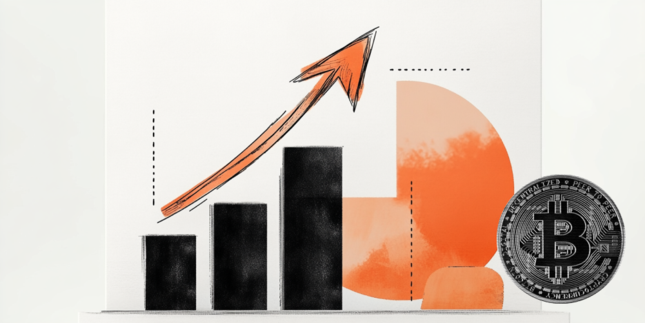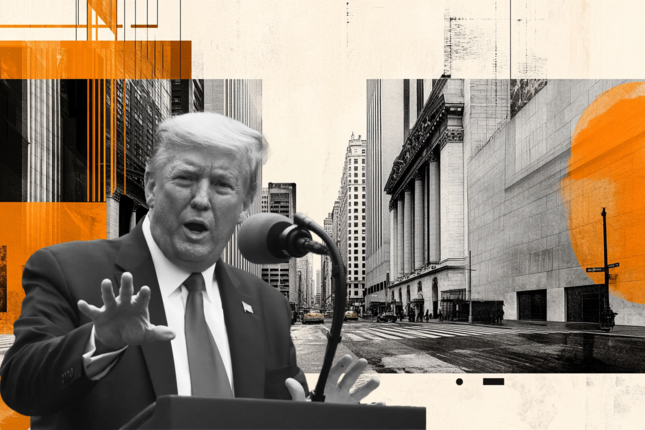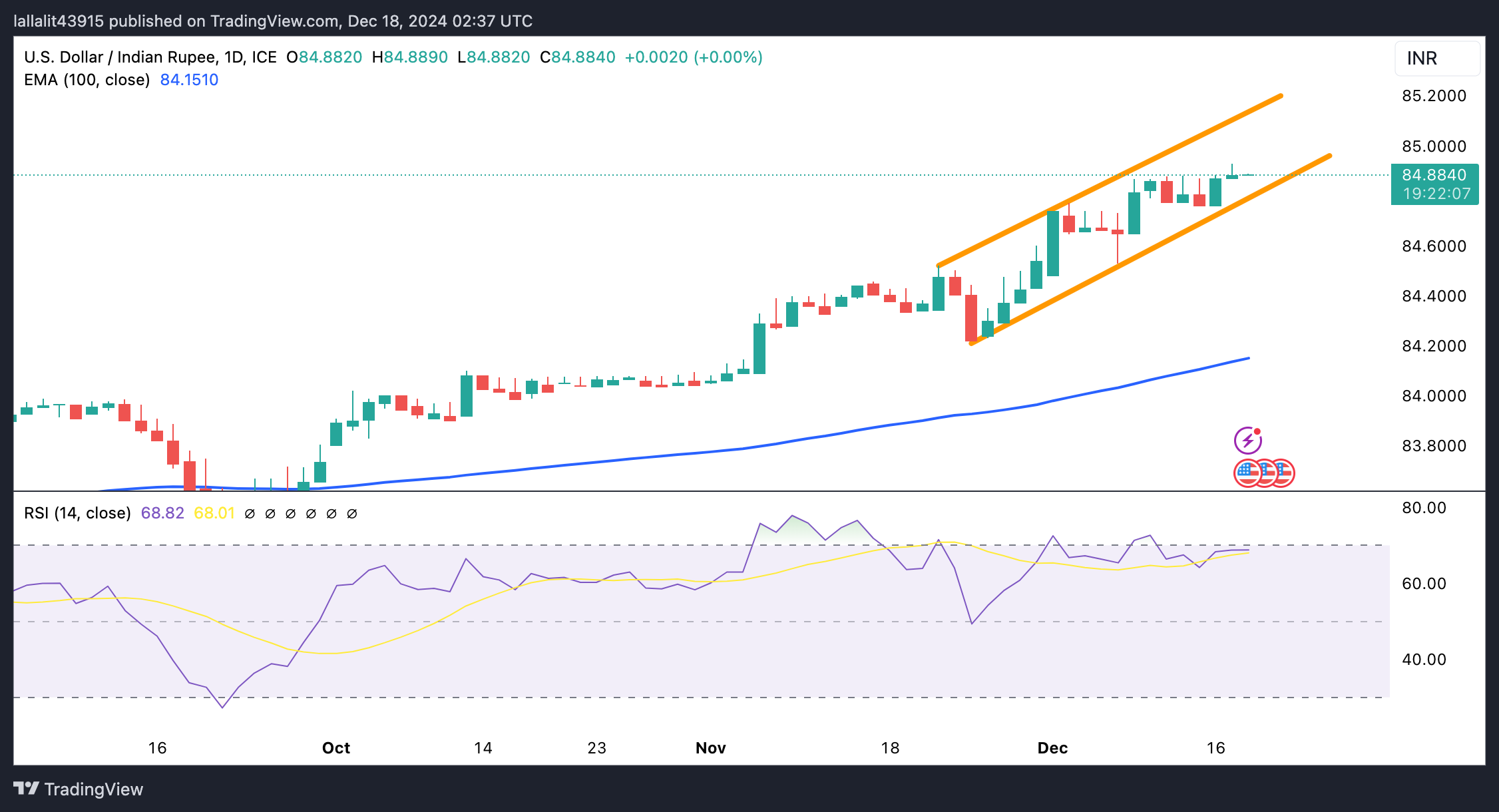- The Indian Rupee softens to near an-all-time low in Wednesday’s early European session.
- Outflows from local equities and the widening of India’s November merchandise trade deficit could weigh on the INR.
- The Fed interest rate decision will take center stage on Wednesday.
The Indian Rupee (INR) trades on a weaker note to near a fresh record low on Wednesday. The local currency remains on the defensive amid persistent demand for US Dollar (USD), foreign fund outflows and a muted trend in domestic equities. Additionally, the widening of India’s merchandise trade deficit in November further undermines the INR. However, the routine foreign exchange intervention by the Reserve Bank of India (RBI) to sell the USD via state-owned banks could prevent the INR from significantly depreciating.
Looking ahead, the US Federal Reserve (Fed) interest rate decision will be in the spotlight on Wednesday. The US Fed is expected to deliver a quarter of a percentage point cut at the December meeting. Traders will closely monitor the Fed Chair Jerome Powell’s Press Conference and the Summary of Economic Projections, or ‘dot plot.’ Any hawkish remarks from the Fed officials might lift the Greenback and contribute to the INR’s downside.
Indian Rupee declines ahead of Fed rate decision
- "While weak Asian cues weighed on market sentiment, the record high trade deficit in November pushed the rupee to a new low, which caused investors to run for cover, triggering panic selling in domestic equities," noted Prashanth Tapse, Senior VP (Research), Mehta Equities Ltd.
- India's merchandise trade deficit widened to a record high of $37.8 billion in November, compared to $27.1 billion in October. Meanwhile, Exports fell by 4.9% YoY to $32.1 billion, while Imports rose 27% YoY to $69.95 billion during the month under review.
- The US Retail Sales climbed by 0.7% MoM in November versus a 0.5% increase (revised from 0.4%) prior, according to the US Census Bureau on Tuesday. This figure came in stronger than the 0.5% increase expected.
- The US Industrial Production declined by 0.1% MoM in November, compared to a fall of 0.4% (revised from -0.3%) in October, below the market consensus of the 0.3% expansion.
- The markets are now pricing in a nearly 97.1% chance of a 25 basis points (bps) cut at the Fed's December meeting, compared with about a 78% chance a week ago, according to the CME FedWatch tool.
USD/INR keeps the bullish vibe in the longer term
The Indian Rupee edges lower on the day. The strong bullish outlook of the USD/INR pair remains in play, characterised by the price holding above the key 100-day Exponential Moving Average (EMA) on the daily timeframe. The upward momentum is supported by the 14-day Relative Strength Index (RSI), which is located above the midline near 68.15, suggesting that the further upside looks favourable.
The first upside barrier for USD/INR emerges near the ascending trend channel and the psychological level of 85.00. Sustained trading above this level could draw in buyers and push the pair to 85.50.
On the flip side, the lower boundary of the trend channel of 84.80 acts as an initial support level for the pair. Bearish candlesticks that could lead to a potential retest of the low of November 25 at 84.22. A breach of the mentioned level could expose 84.15, the 100-day EMA.
Fed FAQs
Monetary policy in the US is shaped by the Federal Reserve (Fed). The Fed has two mandates: to achieve price stability and foster full employment. Its primary tool to achieve these goals is by adjusting interest rates. When prices are rising too quickly and inflation is above the Fed’s 2% target, it raises interest rates, increasing borrowing costs throughout the economy. This results in a stronger US Dollar (USD) as it makes the US a more attractive place for international investors to park their money. When inflation falls below 2% or the Unemployment Rate is too high, the Fed may lower interest rates to encourage borrowing, which weighs on the Greenback.
The Federal Reserve (Fed) holds eight policy meetings a year, where the Federal Open Market Committee (FOMC) assesses economic conditions and makes monetary policy decisions. The FOMC is attended by twelve Fed officials – the seven members of the Board of Governors, the president of the Federal Reserve Bank of New York, and four of the remaining eleven regional Reserve Bank presidents, who serve one-year terms on a rotating basis.
In extreme situations, the Federal Reserve may resort to a policy named Quantitative Easing (QE). QE is the process by which the Fed substantially increases the flow of credit in a stuck financial system. It is a non-standard policy measure used during crises or when inflation is extremely low. It was the Fed’s weapon of choice during the Great Financial Crisis in 2008. It involves the Fed printing more Dollars and using them to buy high grade bonds from financial institutions. QE usually weakens the US Dollar.
Quantitative tightening (QT) is the reverse process of QE, whereby the Federal Reserve stops buying bonds from financial institutions and does not reinvest the principal from the bonds it holds maturing, to purchase new bonds. It is usually positive for the value of the US Dollar.
Information on these pages contains forward-looking statements that involve risks and uncertainties. Markets and instruments profiled on this page are for informational purposes only and should not in any way come across as a recommendation to buy or sell in these assets. You should do your own thorough research before making any investment decisions. FXStreet does not in any way guarantee that this information is free from mistakes, errors, or material misstatements. It also does not guarantee that this information is of a timely nature. Investing in Open Markets involves a great deal of risk, including the loss of all or a portion of your investment, as well as emotional distress. All risks, losses and costs associated with investing, including total loss of principal, are your responsibility. The views and opinions expressed in this article are those of the authors and do not necessarily reflect the official policy or position of FXStreet nor its advertisers. The author will not be held responsible for information that is found at the end of links posted on this page.
If not otherwise explicitly mentioned in the body of the article, at the time of writing, the author has no position in any stock mentioned in this article and no business relationship with any company mentioned. The author has not received compensation for writing this article, other than from FXStreet.
FXStreet and the author do not provide personalized recommendations. The author makes no representations as to the accuracy, completeness, or suitability of this information. FXStreet and the author will not be liable for any errors, omissions or any losses, injuries or damages arising from this information and its display or use. Errors and omissions excepted.
The author and FXStreet are not registered investment advisors and nothing in this article is intended to be investment advice.
Recommended content
Editors’ Picks

Gold surges to fresh record high above $3,400 Premium
Gold extends its uptrend and trades at a new all-time high above $3,400 on Monday. Concerns over a further escalation in the US-China trade war and the Fed’s independence smash the US Dollar to three-year troughs, fuelling XAU/USD's rally.

EUR/USD clings to strong gains near 1.1500 on persistent USD weakness
EUR/USD gains more than 1% on the day and trades at its highest level since November 2021 near 1.1500. The relentless US Dollar selling helps the pair push higher as fears over a US economic recession and the Federal Reserve’s autonomy grow.

GBP/USD tests 1.3400 as USD selloff continues
GBP/USD continues its winning streak, testing 1.3400 on Monday. The extended US Dollar weakness, amid US-Sino trade war-led recession fears and heightened threat to the Fed's independence, underpin the pair following the long weekend.

How to make sense of crypto recovery – Is it a buy or fakeout
Bitcoin (BTC), Ethereum (ETH) and XRP, the top three cryptocurrencies by market capitalization, extend their last week’s recovery on Monday, even as trader sentiment is hurt by the US President Donald Trump’s tariff policy and announcements.

Five fundamentals for the week: Traders confront the trade war, important surveys, key Fed speech Premium
Will the US strike a trade deal with Japan? That would be positive progress. However, recent developments are not that positive, and there's only one certainty: headlines will dominate markets. Fresh US economic data is also of interest.

The Best brokers to trade EUR/USD
SPONSORED Discover the top brokers for trading EUR/USD in 2025. Our list features brokers with competitive spreads, fast execution, and powerful platforms. Whether you're a beginner or an expert, find the right partner to navigate the dynamic Forex market.




